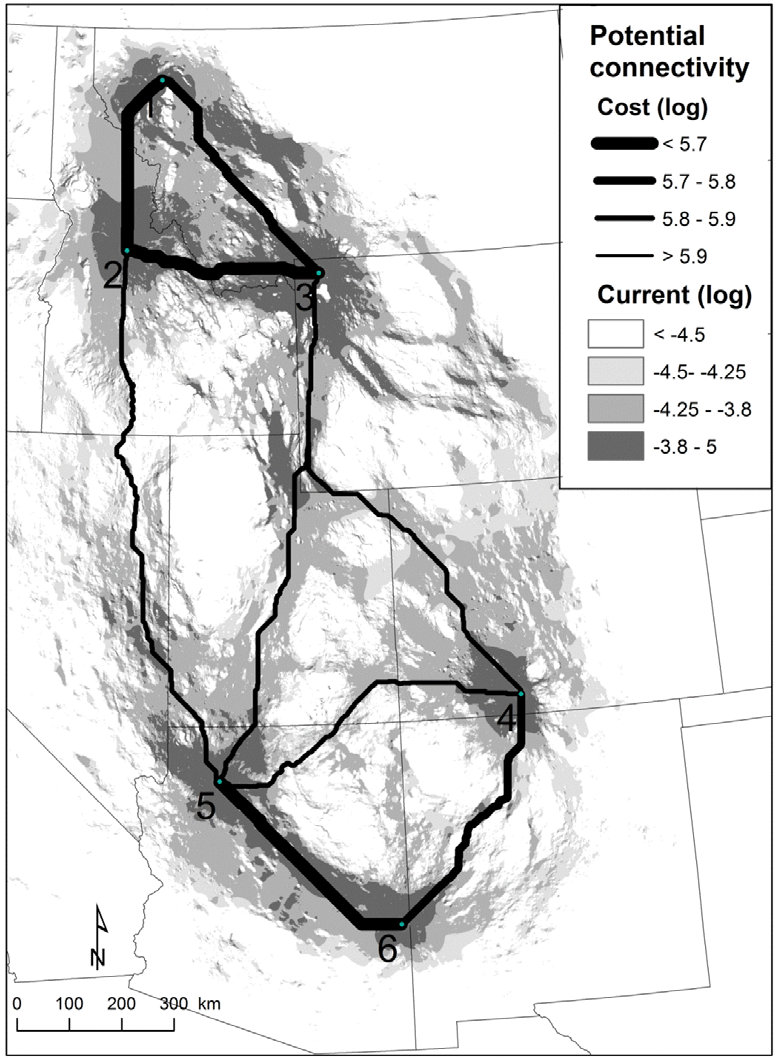PRESS RELEASE
For Immediate Release, September 24, 2013
Contact:
Carlos Carroll, (530) 628-3512
This email address is being protected from spambots. You need JavaScript enabled to view it.
New study forecasts genetic risks to wolves in western US unless dispersal can connect isolated populations
Population of Mexican wolves in southwest US is most at risk. Conclusions present challenges for current FWS wolf delisting proposal.
In a new study published in the journal Conservation Biology (link), researchers have found that long-term prospects for recovery of gray wolves in the western US may hinge on wolves being able to successfully disperse between widely-separated populations. While previous recovery efforts for wolves and other endangered species have acknowledged the importance of such connectivity, this study is the first time that detailed genetic and habitat data for any species have been used to project exactly how many dispersers are needed to sustain genetic health, and what areas offer the best prospects for dispersing wolves to move through. Although wolf recovery has achieved notable successes in areas such as Yellowstone National Park, the study's findings suggest that long-term recovery may depend on overcoming barriers to dispersal in areas where wolf habitat is intermixed with ranchland and human settlements. "This study is the first time that scientists have taken a detailed look at what biology suggests is needed for long-term wolf recovery. Our findings imply that we can't restore formerly widely-distributed species like the wolf to isolated populations in a few parks and expect them to remain genetically healthy", said Dr. Carlos Carroll of the Klamath Center for Conservation Research.

Figure 4 from Carroll et al. 2013. Potential habitat linkages between 6 existing or potential wolf-population core areas in the western United States (thickest lines, linkages with lowest least-cost distance; darkest gray shading, areas with highest importance for connectivity based on the resistance distance model).
The research group led by Dr. Carroll included two scientists from the Mexican Wolf Recovery Team. The Team was convened in 2010 to draft a recovery plan for the subspecies, which at only 75 individuals in the wild is among the most endangered mammals in North America. To support the Recovery Team effort, the scientists analyzed information on the pedigrees of wild and captive Mexican wolves, and forecast the potential future for Mexican wolves if their population remained isolated or was connected to other populations. They found that as isolated populations became increasingly inbred, the number of wolves in each litter declined, leading many populations to go extinct. Projections were made using a computer simulation model called Vortex developed by Dr. Robert Lacy of the Chicago Zoological Society (link). The researchers then used methods first developed to design electrical circuits (link) to map which areas of habitat held the best prospects for allowing dispersing wolves to survive and reach another population.
The study's findings have implications for the current US Fish and Wildlife proposal to delist (remove federal protections for) wolves across the western US, outside of a single population of Mexican wolves in Arizona and New Mexico. Although the study is now completed, the Mexican Wolf Recovery Plan which spurred the research effort is on hold, after the last scheduled recovery team meeting in June 2012 was cancelled at short notice, a development that has been attributed to qualms about the political implications of the scientists' findings (link).
Link to paper: http://onlinelibrary.wiley.com/doi/10.1111/cobi.12156/abstract
Dr. Carlos Carroll is an ecologist with the Klamath Center for Conservation Research, in Orleans, California. His research focuses on habitat, viability, and connectivity modeling for a diverse group of threatened and endangered species ranging from large carnivores to rare and endemic plant species. He is the developer of the freely-available Connectivity Analysis Toolkit software that assists planners in identifying and conserving wildlife linkages. Dr. Carroll serves on the Board of Governors of the Society for Conservation Biology. More information about his research can be found at www.klamathconservation.org.
A pdf file of the paper is available to read here: ![]() Carroll et al. 2013815.22 KB
Carroll et al. 2013815.22 KB





